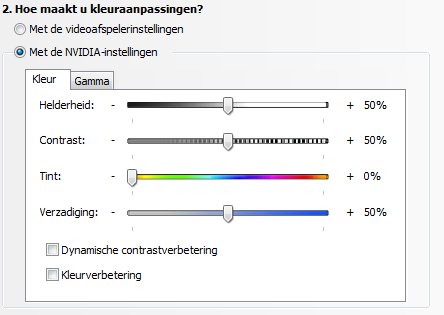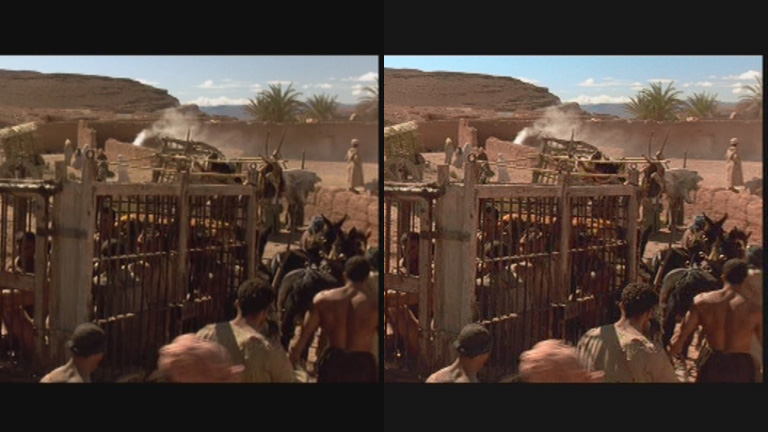4 - PureVideo HD
PureVideo Enhancements
PureVideo HD is a video engine built into the GPU of your graphics card (dedicated core logic). It allows for dedicated GPU-based video processing to accelerate, decode and enhance image quality of low and high definition video in the following formats: H.264, VC-1, WMV/WMV-HD, and MPEG-2 (HD). Speaking more generic; your graphics card can be used to decode SD/HD materials in two categories:
HD Acceleration
The more your graphics card can decode the better, as it'll lower the overall used CPU cycles of your PC. We'll measure with the two most popular codecs used on both Blu-Ray and HD-DVD movies. VC1 is without a doubt the most used format, and secondly, the hefty, but oh so sweet H.264 format. We'll fire off a couple of movies and allow the graphics cards to decode the content; meanwhile like a vicious minx we'll be monitoring and recording the CPU load of the test PC.
HD Quality
Not only can the graphics card help offload processing from the the CPU, it can also improve (enhance) image quality; as it should. So besides checking out performance of AMD's Avivo HD and NVIDIA's PureVideo HD video engines, we want to see how they affect the image quality, e.g. post-process and enhance the image quality of the movie.
Basically, in the entire GeForce Series 8 and obviously the new Series 9 range we see a 10-Bit display processing pipeline and also new post-processing options like:
- VC-1 & H.264 HD Spatial-Temporal De-Interlacing
- VC-1 & H.264 HD Inverse Telecine
- HD Noise Reduction
- HD Edge Enhancement
- HD Dynamic Contrast Enhancement
- HD Dynamic Color Enhancement
Today's newly added features in bold will be available for all GeForce series 8 & 9 products. With the GeForce 9800 GT comes the exact same VP2 decoding engine as found on the 8800 GT. You'll have your low-CPU post-processed, decoding 1080P image quality options with HD-DVD and Blu-Ray just like the 8800 GT with the new Video Processor 2 engine built in. I quickly verified; the HQV-HD score is at it's maximum 100 points and thus working like a charm.
 Now read the topic carefully as with this new release we mainly talk about enhancements. In the upcoming drivers you'll notice the addition of two new features: Dynamic Contrast and Color enhancement.
Now read the topic carefully as with this new release we mainly talk about enhancements. In the upcoming drivers you'll notice the addition of two new features: Dynamic Contrast and Color enhancement.
It does pretty much what the name says; Dynamic Contrast Enhancement technology will improve the contrast ratios in videos in real-time on the fly. It's a bit of a trivial thing to do, as there are certain situations where you do not want your contrast increased. Think for example a scary thriller, dark environment... and all of a sudden your trees light up. So with that in mind; the implementation has been done very delicately. It does work pretty well, but personally I'd rather tweak the contrast ratio myself and leave it at that.
To the right you can see a screenshot where the new options are located, and yes, sorry for the Dutch language.
** Idea for NVIDIA's driver team, selectable languages in the ForceWare drivers.
The second feature is Dynamic Color Enhancement. It's pretty much a color tone enhancement feature and will slightly enforce a color correction where it's needed. We'll show you that in a bit as I quite like this feature; it makes certain aspects of a movie a little more vivid.
Also a small new addition for Vista Aero enthusiasts; previously when you played back a movie while utilizing the graphics processor with software like PowerDVD, you thus had to shut down Vista Aero and revert back to the basic Vista theme; this has now been solved and window transparency, thumbnail previews etc are all working as they're intended to.
Also new is a feature called Dual-Stream decode. Pretty much it boils down to the fact that you can display two video streams simultaneously. Pretty handy if you watch a Blu-Ray movie with a small director's commentary window on the lower part of your screen.

Let's split the frames in two and compare with all interesting tweaks enabled. Two older features, edge enhancement and noise reduction obviously are also at your disposal. To the left the baseline (first) image, to the right the final result. Once we enable these as well and combine them with the Dynamic Contrast Enhancement and Color Enhancement option we see a distinct difference in image quality. Thanks to edge enhancement the frame is more sharp.
